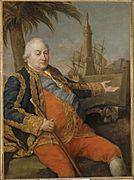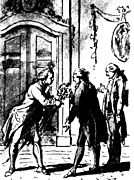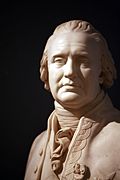Pierre André de Suffren facts for kids
Quick facts for kids
Pierre André de Suffren
|
|
|---|---|
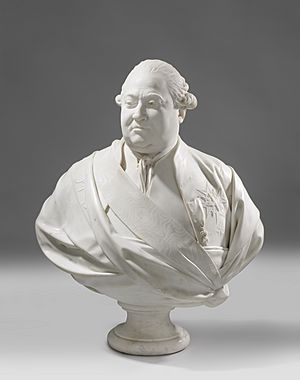
Bust of Suffren by Jean-Antoine Houdon
|
|
| Nickname(s) | Jupiter |
| Born | 17 July 1729 Château de Saint-Cannat, France |
| Died | 8 December 1788 (aged 59) Paris, France |
| Buried |
Ashes defiled in 1793 by the Revolutionaries
|
| Allegiance | |
| Service/ |
|
| Years of service | 1743–1784 |
| Rank | Vice-admiral in the French Navy General of the Galley of Malta |
| Unit | Indian Ocean squadron |
| Battles/wars | War of the Austrian Succession: |
| Awards | Order of Saint-John of Jérusalem |
Pierre André de Suffren (born July 17, 1729 – died December 8, 1788) was a famous French Navy officer and admiral. He started his naval career during the War of the Austrian Succession. He also fought in the Seven Years' War and the American Revolutionary War.
Suffren is best known for his amazing battles in the Indian Ocean. He led a squadron of 15 ships against the British Vice-Admiral Sir Edward Hughes. Suffren fought five tough battles and helped France control the seas in the Indian Ocean. When he returned to France, he was promoted to vice-admiral.
Contents
Biography of Admiral Suffren
Pierre André de Suffren was born on July 17, 1729, in France. His family was part of the old French nobility. When he was just 14 years old, in October 1743, Suffren began his naval studies. He joined the navy as a "Garde-Marine" (a naval cadet) in Toulon. He spent only six months on land before he was assigned to a ship.
Fighting in the War of the Austrian Succession
Suffren served on a ship called Solide and fought in the Battle of Toulon in 1744. Later, he joined the ship Trident and took part in a big expedition to America.
In 1747, Suffren became an ensign. He helped prepare a new ship, the Monarque, for battle. He fought in the Second Battle of Cape Finisterre on October 25, 1747. His ship was badly damaged and captured, and Suffren was taken prisoner.
After the war ended in 1748, Suffren joined the Order of Malta. He sailed on merchant ships, protecting them from pirates. In late 1754, he returned to France.
Service during the Seven Years' War
By 1756, Suffren was a Lieutenant. When the Seven Years' War began, he joined the ship Orphée. This ship was part of a squadron that helped transport 12,000 soldiers to attack Minorca. The French squadron fought the British in the Battle of Minorca. The British could not break the French blockade, and the French captured Fort St. Philip.
In 1757, Suffren moved to the ship Océan. His squadron was blockaded by the British in Cartagena. Later, in August 1758, his squadron tried to escape the blockade. In the Battle of Lagos, Océan ran aground and was burned by the British. Suffren was taken prisoner again. He returned to France after several months but did not have a ship to command for some years.
Between the big wars
When peace returned in 1763, Suffren commanded a small ship called Caméléon. He used it to fight against Barbary pirates. He was later promoted to frigate captain in 1767.
After another expedition, Suffren went back to Malta. He spent four years there, moving up in the Order of Malta. In 1772, he became a Captain in the French Navy. He commanded the frigate Mignonne and sailed in the Eastern Mediterranean. From 1776, he commanded the frigate Alcmène, training new navy officers.
Fighting in the American Revolutionary War
In 1778, tensions grew between France and England, leading to France joining the American Revolutionary War. Suffren was appointed to Admiral d'Estaing's fleet. He commanded a division that included his ship, the Fantasque.
His mission was to support American and French efforts in the Battle of Rhode Island. On August 5, 1778, Suffren entered Narragansett Bay. He forced the British to sink their own ships to avoid capture.
The French fleet then sailed to Martinique and then to Grenada. In the Battle of Grenada on July 6, 1779, Fantasque was at the front of the battle. She took heavy fire and had many men killed or wounded. After the battle, Suffren helped secure the surrender of nearby islands.
On September 7, 1779, Suffren was ordered to blockade the Savannah River. This was to help the Siege of Savannah and stop British ships from escaping. He sailed into the river, forcing the British to sink several of their own ships.
In 1780, King Louis XVI gave Suffren a pension for his service. Suffren later joined a combined French and Spanish fleet. On August 9, they captured a large British convoy. Suffren chased some British warships, but they were faster because their hulls were covered in copper. This made Suffren realize that French ships also needed to be copper-plated.
The Indian Ocean campaign
When the Fourth Anglo-Dutch War started, France and the Dutch Republic became allies against Britain. Suffren was given command of a five-ship squadron. His mission was to reinforce the Dutch Cape Colony in South Africa. His task force included the ships Héros, Annibal, Artésien, Sphinx, and Vengeur, plus a corvette and seven transport ships. Most of these ships had copper plating on their hulls.
Battle of Porto Praya
The squadron left France on March 22, 1781. On April 16, they arrived at Praia Harbor in Santiago. Suffren spotted five British warships already anchored there. Ignoring the rules of neutrality, Suffren ordered an immediate attack. His squadron attacked, surprising and disorganizing the British.
After the battle, Suffren quickly sailed to the Cape of Good Hope, arriving on June 21. His troops landed and began fortifying the colony. The fleet repaired its ships and cared for the sick. Suffren then sailed to Mauritius, arriving on July 28.
Preparing for battle in the Indian Ocean
Before Suffren arrived, the French colony of Pondichéry in India had a small squadron. This squadron had been reinforced over time. By 1780, Thomas d'Estienne d'Orves was in command of six ships of the line.
Suffren arrived in Mauritius on October 25, 1781. This island was chosen as the main base for French operations in the Indian Ocean.
On December 7, 1781, d'Orves led a large fleet towards Ceylon. He had 11 ships of the line. On January 19, 1782, a French ship spotted a strange sail. Suffren's ships chased it. On January 22, Suffren caught the ship and forced it to surrender. It was the British ship HMS Hannibal, which the French then used as Petit Annibal.
Battle of Sadras
In the days that followed, d'Orves became very ill. He gave command to Suffren. The French planned to surprise the British ships at Madras. The French fleet arrived north of Madras on February 5, 1782. However, strong winds trapped them there. Meanwhile, the British squadron, led by Admiral Hughes, arrived at Madras.
D'Orves died on February 9. Suffren took full command. On February 14, the winds changed, allowing Suffren's squadron to sail south. Suffren saw that Hughes was in a very strong defensive position. He decided to sail away, but Hughes left the safety of the forts and chased him.
On February 17, the two fleets were close. The British had captured one French transport ship. Suffren quickly formed his ships into a battle line. At 3:00 PM, he closed in and started the Battle of Sadras. Suffren's ships suffered light damage and about 30 men killed and 100 wounded. At 7:00 PM, he broke contact.
Battle of Providien
Suffren returned to Pondichéry on February 19, 1782. He learned that the British squadron was heading for Trincomalee. Suffren then went to Porto Nove, where he met with Hyder Ali, a local Indian leader. They made an agreement for French troops to work with Hyder Ali's army. Suffren landed his troops and then sailed on March 23 to find the British fleet.
On April 10, the two fleets saw each other. They spent two days trying to gain an advantage. On April 12, the Battle of Providien began. Both squadrons were damaged. Suffren retreated to the Dutch forts of Batacalo to make repairs and care for his wounded and sick crew.
Battle of Negapatam
On June 3, 1782, Suffren sailed to Cuddalore. He received a request from Hyder Ali to lay siege to Nagapattinam. As French troops were re-embarking, Suffren learned that Hughes' squadron was at Nagapattinam. Suffren immediately set sail and found the British ships anchored there on July 6.
The Battle of Negapatam followed. The two fleets exchanged fire for over four hours until Hughes retreated. During the battle, the captain of the French ship Sévère tried to surrender, but his officers refused and kept fighting. This caused serious damage to a British ship that had stopped to capture Sévère.
Suffren stayed near Nagapattinam to watch the British. He then returned to Cuddalore to repair his ships. Suffren was very angry about the attempted surrender of Sévère. He removed several captains and officers from their commands.
Battle of Trincomalee
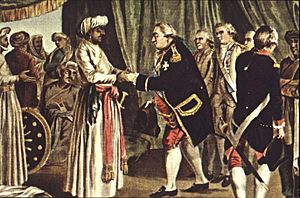
On July 25, 1782, Hyder Ali arrived at Bahour. The next day, Suffren and his officers met with Hyder Ali. Suffren announced that more French ships and 5,000 soldiers were arriving. Hyder Ali gave Suffren and his officers many gifts. They discussed plans to fight the British.
Meanwhile, the French squadron was making repairs. In early August, Suffren learned that the British fleet had left Nagapattinam. Suffren sailed to Batticaloa, where he learned that more French ships and troops were waiting for him at Galle. Suffren decided to lay siege to Trincomalee.
On August 25, the French fleet arrived at Trincomalee. Two thousand men landed quickly with artillery and supplies. By August 29, the French began bombarding the fort. On August 30, the fort surrendered. The next day, another fort, Fort Ostenburg, also surrendered.
On September 3, the British fleet arrived. Suffren re-embarked his troops and moved to intercept them. This led to the Battle of Trincomalee. The French line was disorganized, and one ship caught fire. Suffren's flag was shot down, but he quickly hoisted new ones. After an hour and a half, night fell, and the battle ended. Suffren was very angry with his captains for their poor performance. The next day, the British fleet had disappeared. Suffren returned to Trincomalee on September 7, 1782.
Battle of Cuddalore
After the Battle of Trincomalee, Suffren's ships were badly damaged. They anchored at Trincomalee for two weeks to make repairs. Some captains who did not get along with Suffren asked to be relieved of duty. Suffren sent them back to France.
Suffren then received news that Hyder Ali had left Cuddalore, making the city vulnerable to a British attack. Cuddalore was a very important supply base, so Suffren had to protect it. Suffren left Trincomalee on October 1 and arrived at Cuddalore on October 4. The British attack did not happen. On October 12, the change in monsoon winds forced both fleets to find shelter. Hughes went to Bombay, while Suffren chose to sail to Aceh.
The French squadron arrived at Aceh on November 1. They spent weeks repairing ships and caring for the sick. Later, a ship arrived with news that more French ships, troops, and supplies were on their way.
Suffren's fleet set sail on December 20 to return to India. On the way, they raided a British colony. On January 12, 1783, they captured a British frigate. From the prisoners, Suffren learned that Hyder Ali had died. The fleet continued to Cuddalore, arriving on February 1. More French ships and transports arrived shortly after.
With better weather, Suffren expected Hughes' attack. His own ships were damaged or only partly repaired. He quickly landed his troops at Cuddalore and sailed for Trincomalee. On May 24, Hughes' squadron passed Trincomalee. A few days later, Suffren learned that Cuddalore was under siege and blockade.
Suffren left Trincomalee on June 11, 1783. On June 16, his ships spotted 18 British ships. Suffren went on a frigate to scout the situation himself. The two fleets approached each other but did not engage that evening. The next morning, the French were at the entrance of Cuddalore Bay. Suffren anchored his ships and brought 1,200 soldiers from shore to help man his ships. On June 18, Suffren set sail, and the two squadrons chased each other for two days, trying to get an advantage. Finally, on June 20, the two fleets engaged in the Battle of Cuddalore.
On June 25, Hughes retreated to Madras. On June 29, a British frigate arrived with news of a preliminary peace agreement signed on February 9, 1783. Hughes offered a cease-fire, which Suffren accepted. On July 25, another French frigate arrived with news of the official Peace of Paris and orders for Suffren to return to France.
After the war
Suffren's squadron arrived at Trincomalee on August 8. Suffren himself sailed to Pondichéry on September 15 to meet with Bussy. There, he learned he had been promoted to Lieutenant General of the Naval Armies. He returned to Trincomalee on September 26. The fleet left for Europe on October 6. On his way, Suffren stopped at the Cape of Good Hope. Hughes' squadron also arrived there. One British ship ran aground, and both French and British ships sent boats to help.
Suffren arrived back in Toulon, France, on March 26, 1784. He was called to Versailles and was greatly celebrated by the Navy Minister and King Louis XVI. A special position of Vice-Admiral was created just for Suffren. He died in Paris on December 8, 1788, shortly before he was to take command of the French fleet at Brest.
Legacy and impact
Assessment of his command
Suffren is generally seen as a very skilled naval commander. The Encyclopædia Britannica called him "perhaps the ablest sea-commander that France ever produced." Mahan, a famous naval historian, wrote that Suffren correctly focused on defeating the enemy fleet first, which was different from common French naval ideas at the time.
Admiral Ernest King, a US Navy leader in World War II, listed Suffren as one of his five favorite admirals from history. Some people, however, had mixed feelings about him. Some described him as a "hard man" who was "bad-tempered" and "liked of no one." Others say that while he was brave and tactically brilliant, his poor social skills meant he was sometimes misunderstood by his captains.
Monuments and memorials
Eight ships of the French Navy have been named Suffren in his honor. Many streets and avenues in France are also named after him. In Paris, the Avenue de Suffren runs next to the famous Champ de Mars.
- Depictions of Suffren
-
Suffren, by Pompeo Batoni.
See also
 In Spanish: Pierre André de Suffren de Saint Tropez para niños
In Spanish: Pierre André de Suffren de Saint Tropez para niños


